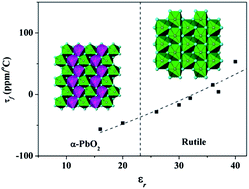Stabilization and tunable microwave dielectric properties of the rutile polymorph in α-PbO2-type GaTaO4-based ceramics†
Abstract
The effects of Ti substitution on the crystal chemistry and microwave dielectric properties of Ga1−xTa1−xTi2xO4 were investigated. GaTaO4 adopts a 1:1-ordered monoclinic α-PbO2 type structure. At 1300 °C the Ga1−xTa1−xTi2xO4 system formed a monoclinic α-PbO2 type solid solution when x ≤ 0.05, and further Ti substitution in Ga1−xTa1−xTi2xO4 induced a phase transformation from α-PbO2 to rutile, leading to a rutile solid solution when x ≥ 0.15. Within the intermediate composition range 0.075 ≤ x ≤ 0.1, a mixture of α-PbO2 and rutile phases formed, which gradually transformed into a single rutile phase upon being fired at 1350–1400 °C. At 1400 °C the compositions where x = 0–0.025 remained in monoclinic α-PbO2 type phases, while the x = 0.05 composition transformed into a rutile polymorph, implying that Ti substitution is favorable for stabilizing the high temperature rutile polymorph of GaTaO4 down to room temperature. The monoclinic Ga1−xTa1−xTi2xO4 (x = 0, 0.05) ceramics exhibited a low permittivity (εr) values of ∼16–20, high Qf values ∼45 000–68 000 GHz and large negative temperature coefficients of the resonance frequency, τf of −56 ppm °C−1 to −47 ppm °C−1. Ti substitution in Ga1−xTa1−xTi2xO4 increased εr to ∼40 and τf to ∼53 ppm °C−1 in the range x = 0–0.4, while the Qf values exhibited a tendency to decrease with Ti substitution. The rutile solid solution showed, for the first time, a tunable τf from a negative value to a positive value and optimum microwave dielectric properties were achieved for rutile Ga0.75Ta0.75Ti0.5O4: εr ∼ 37, Qf ∼ 30 000 GHz and τf ∼ 4.4 ppm °C−1. The factors controlling the dielectric loss and τf in Ga1−xTa1−xTi2xO4 are discussed in terms of the polymorphism, defects, charge disorder and polarizability associated with the Ti substitution.


 Please wait while we load your content...
Please wait while we load your content...